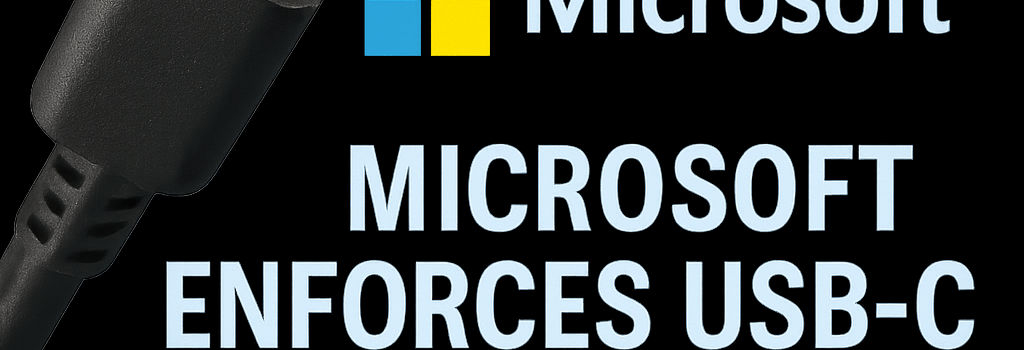Microsoft Enforces USB-C Standard on Windows PCs

After more than a decade of gradual adoption, the USB Type-C connector has become ubiquitous on Windows laptops, tablets, and peripherals. But persistent inconsistencies in how manufacturers implement data, power, and alternate-mode features have left end users frustrated. In a recent update to its Windows Hardware Compatibility Program (WHCP), Microsoft is now mandating a common feature baseline for every USB-C port on certified Windows PCs—finally guaranteeing that “USB-C just works.”
Background: The Promise and Pitfalls of USB-C
The reversible USB-C plug was introduced by the USB Implementers Forum (USB-IF) as a single, compact solution for power delivery, data transfer, and video output. However, the USB-C physical specification was published separately from:
- The USB 3.x and USB4 data protocols
- USB Power Delivery (PD) profiles
- Alternate Mode extensions (DisplayPort, HDMI, PCIe/Thunderbolt)
As a result, OEMs have shipped ports with wildly different capabilities—some only support USB 2.0 charging, others handle 100 W PD but lack DisplayPort Alt Mode, and only a handful deliver full USB4 or Thunderbolt 4 performance.
Microsoft’s Baseline Requirements in WHCP
According to Microsoft’s USB Blog post by Senior Product Manager Ugan Sivagnanenthirarajah, Windows diagnostic telemetry reveals that 27 percent of PCs with USB4 show a “limited functionality” warning when users connect high-bandwidth or alternate-mode devices. To address this, the WHCP now requires every built-in USB-C port on a Windows PC to support:
- USB 3.1 Gen 1 speeds (5 Gbps) minimum
- USB Power Delivery for host charging and at least 4.5 W (5 V/0.9 A) to accessories
- Alternate Mode for at least one external DisplayPort or HDMI output
- Use of Windows’ in-box usbccgp.sys driver stack for universal updates
Manufacturers can still opt for higher tiers—including 10, 20, or 40 Gbps USB speeds, Thunderbolt 4/5 support, and PD profiles up to 240 W under PD 3.1 EPR—but these are now optional enhancements rather than necessities.
Latest Extensions: USB 4 v2.0, PD 3.1 EPR, and Regulatory Landmarks
In March 2025, the USB-IF ratified USB4 v2.0, doubling maximum aggregated throughput to 80 Gbps over certified Type-C cables and host controllers. At the same time, PD 3.1 Extended Power Range (EPR) standards have been finalized, enabling up to 240 W (48 V/5 A) charging over high-precision E-marker cables. Meanwhile, regulatory bodies in the EU and US are pushing for universal chargers—further pressuring OEMs to fully embrace USB-C as a one-cable solution.
Technical Deep Dive: CC Lines, VCONN, and Alternate Modes
The USB-C receptacle contains two Configuration Channel (CC) pins that handle:
- Plug orientation detection and role negotiation (host/device)
- Power Delivery communication via the PD protocol
- VCONN power to active cables and adapters
Sideband Use (SBU) pins carry non-USB signals for DisplayPort or HDMI Alt Mode. Implementing full support requires a certified USB-IF PD controller, high-speed multiplexers, and sometimes separate retimer or redriver ICs—components that can increase BOM costs but ensure compliance and signal integrity.
Ecosystem Compliance and Manufacturer Challenges
OEMs now face two major hurdles:
- Hardware Certification: Integrating USB-IF certified controller chips (from TI, Renesas, Cypress, etc.) and validating cables with proper E-marker chips.
- Software Updates: Adhering to the WHCP requirement to use Microsoft’s in-box drivers, allowing bug fixes and new feature rollouts via Windows Update rather than individual vendor downloads.
Although adding these components raises costs slightly, it eliminates customer support cases related to docking stations, external GPUs, and high-refresh displays failing to function over USB-C.
Expert Opinions
“Microsoft’s decision to enforce a clear baseline finally aligns PC makers on the same page. It benefits both consumers and IT departments by reducing compatibility headaches,” said Jane Roberts, USB-IF Technical Marketing Manager.
“OEMs will now have to standardize on PD 3.0 controllers and certified cables—but the upside is reduced returns and fewer support tickets,” added Dr. Alan Chen, Senior Analyst at TechInsights.
The Road Ahead: Ensuring a Single-Cable Future
With Microsoft’s WHCP baseline, the USB-C landscape on Windows PCs takes a major step toward the “do-everything” promise. Future milestones to watch include:
- USB4 v2.0 ecosystem maturity—host and device controllers shipping in volume by late 2025.
- PD 3.1 EPR adoption—particularly in gaming laptops and mobile workstations requiring >100 W charging.
- Regulatory enforcement—EU and US mandates on charger compatibility driving further standardization.
While there will always be premium tiers for Thunderbolt and proprietary docks, Microsoft’s intervention ensures that the lowest common denominator across all Windows portables now delivers reliable charging, display output, and high-speed data—no guessing, no gotchas.
Conclusion
By codifying USB-C requirements in its WHCP, Microsoft is leveraging its role as the primary OS vendor to unify a fragmented connector ecosystem. This initiative not only reduces end-user frustration but also lays the groundwork for smoother deployments of next-generation USB4 v2.0 and PD 3.1 EPR technologies—paving the way for a true single-cable experience.